Shanghai Tour 9 - Huacao Town (华漕镇)
- Jinwook Chang
- Mar 1, 2024
- 8 min read
Updated: Aug 8
Discover the fusion of serene parks, international flair, and reimagined tradition on this laid-back cycling journey through Shanghai’s Huacao Town.
Total Distance: 5 km | Total Hours: 6~8 Hours (Light Biking, Heavy Touring)
Main Destinations:
Shanghai American School (上海美国学校)
Fashion Mall (丰尚国际)
Zhudi Park (诸翟公园)
Panlong Tiandi (蟠龙天地)
Map:

Main Blog:
On February 9th, the Bike in Shanghai group set out on its ninth trip through Huacaozhen, exploring Minhang District’s suburban neighborhoods, international plazas, and newly developed historical sites.
Shanghai American School (上海美国学校)
Shanghai American School (SAS) is one of the oldest (est 1912) and most prestigious international schools in China, offering a U.S.-based curriculum from Pre-K to Grade 12 on a large, well-equipped campus in western Shanghai.
As you bike toward western Shanghai, you encounter Shanghai American School (SAS), the home of the Eagles. SAS is the hub of a vibrant international community in Shanghai, as the home of 2,000 or more students from Pre-K to Grade 12. On special days like the Spring Carnival in mid-April and the International Fair in late September, the westside international community gathers at the SAS Puxi campus to share food, play games, enjoy student performances, and celebrate global cultures with music, crafts, and community booths.
During the international fair, most high school students who are engaged with the 80+ clubs in SAS host booths to promote their clubs and enjoy the fair. Foreigners (people unrelated to the school) are free to visit the campus during both the spring carnival and the international fair after a brief security check, so remember to save the dates!
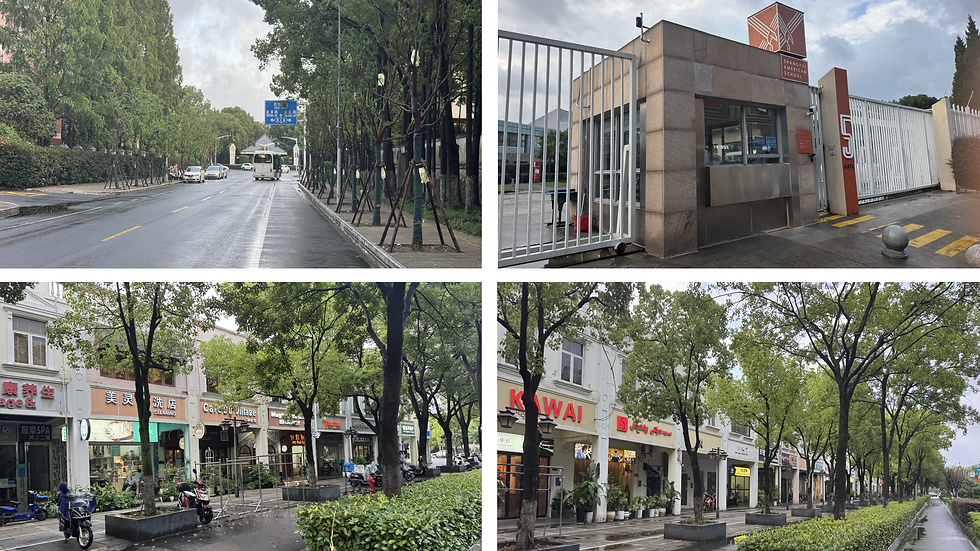
On the opposite side of Shanghai American School, there is the International Plaza—Fashion Mall. However, here I want to talk more about the international stores along Baole Road (保乐路), near Shanghai American School. Just a five-minute walk away from SAS, Baole Road comprises a blend of Chinese and international culture. As you see in the photos above, there is a mix of Mandarin and English on the store signs as well.
There are small supermarkets, restaurants, and cafés along the street, and also my favorite—Café du village. There are small supermarkets, restaurants, and cafés along the street, and also my favorite—Café du Village. Café du Village, located at 620 Baole Road in Minhang, is a cozy, locally beloved spot known for its house-roasted specialty coffee, gourmet café-style meals, and consistently praised breakfast offerings like Eggs Benedict and smoothies—a perfect place for brunch!
On the opposite side of SAS Gate 5 and on the opposite side of the block for Baole Road street, you arrive at the Fashion Mall.
Fashion International Plaza (丰尚国际)
Fengshang International Plaza is a neighborhood shopping mall tucked into Huacaozhen, Minhang District, featuring casual international cuisine—including Italian, Japanese, Korean, Vietnamese, and Chinese—along with pet care shops, beauty services, and a relaxed atmosphere for local errands and light shopping.

The Fashion International Plaza, or Fashion Mall, as locals usually call it, is a vibrant international mall featuring international cuisine. As you walk into Fashion Mall, you are now at the hub of the Western Shanghai international community: you will start to hear English more often than Chinese and see more English than Chinese on store signs. Although you may have been slightly disappointed at the local restaurants with your country's food, here it replicates the exact taste of your country.
Some of the most popular restaurants around include Luke's Bistro, Favorita, and Pizza Marzano, serving Italian food; BBQ Chicken, serving Korean food; and Grill, Sushi, Beer, serving Japanese food. For a more budget-friendly option, Mr. Pancake offers pancakes, burgers, and steak at surprisingly low prices.
After lunch at Fashion Mall, head over to the nearby local park for a leisurely stroll—soak in the atmosphere, observe daily life up close, and maybe even jump into a friendly game of basketball with the locals as you experience Chinese culture firsthand.
Zhudi Park (诸翟公园)
Zhudi Park is a peaceful neighborhood park nestled in Huacaozhen, offering shaded walking paths, small bridges, and open spaces surrounded by villas. It's a quiet retreat where locals gather for morning exercise, casual strolls, and the occasional pickup basketball game—perfect for experiencing suburban Shanghai life up close.
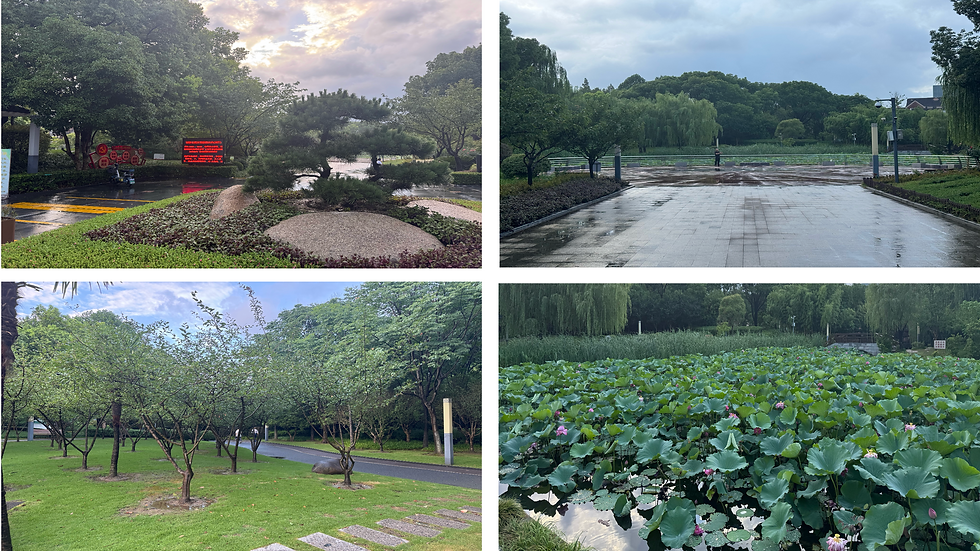
As you walk into Zhudi Park, as always, you encounter the red circle signs (if you do not recognize it, go read the Shanghai Tour 1!). As we moved deeper into the park, the path opened up into a wide plaza surrounded by willow trees and trimmed hedges. A single person walked slowly down the middle, adding to the quiet, unhurried energy of the place.
To the left, a grove of neatly spaced fruit trees stretched over a soft, grassy field. It looked like a place where local residents might come to stretch, walk their dogs, or just take a deep breath away from traffic and noise. Further down the trail, we arrived at the highlight of the park—a vibrant lotus pond in full bloom. Pink flowers floated on layers of green, framed by reeds and drooping willows, with a small bridge in the background completing the picture.
The plaza is packed every evening with middle-aged men and women dancing for fitness, a routine known as public square dancing (广场舞). A group of 20 to 30 people—many of whom are complete strangers—gather to dance together to upbeat music, all following a leader at the front as a form of group exercise. In larger public squares, hundreds can be seen dancing in sync. The plaza also fills with families in the evening, as kids run around playing tag, jumping rope, or simply strolling through the park. It’s a great spot to people-watch and immerse yourself in local life. With its surrounding greenery and relaxed pace, it’s the perfect place to unwind and absorb the neighborhood’s atmosphere.
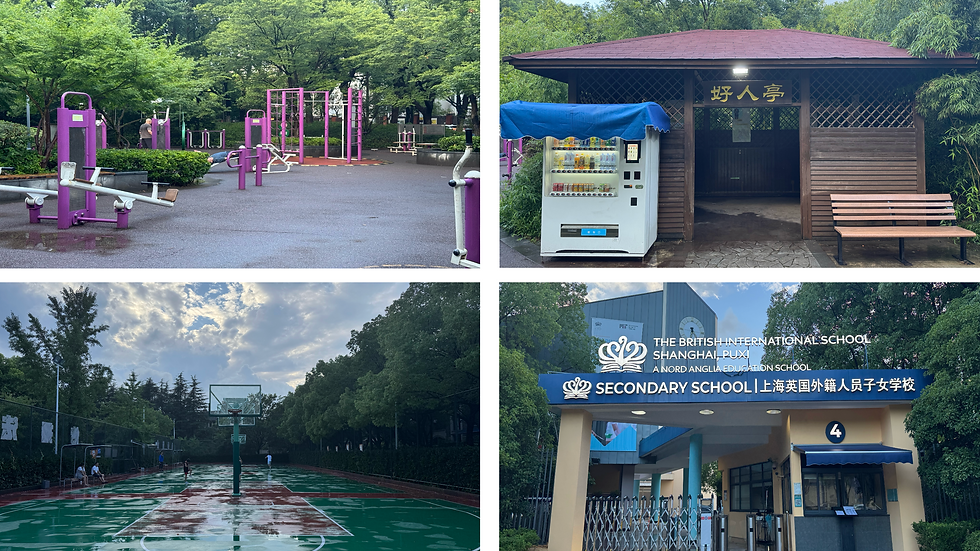
As you walk toward the left, you’ll notice a small shelter where locals often gather to play card games, take cover during rainy seasons, or simply enjoy a quiet cup of tea. Right next to the shelter is an outdoor gym area, equipped with bodyweight workout machines. You’ll see setups like this all across East Asia—especially in China, Korea, and Japan. I’ve visited many of them growing up, often accompanying my grandparents during their exercise routines. In the afternoon, the area is usually active, with people doing sit-ups, pull-ups, or twisting stretches to relieve the stiffness from work. Surrounded by lush green trees, it’s a peaceful and refreshing place to slow down and take in the calm.
As you continue walking in the same direction, the rhythmic bounce of basketballs begins to echo through the trees. It leads you straight to the local court—painted in the classic Chinese style, with green outside the paint and red inside. It’s free to use, and the community is incredibly welcoming to newcomers and foreigners alike. If you enjoy playing basketball, this is the perfect place to jump into a casual game and blend in with the local crowd. During weekday evenings and weekends, the court is usually packed, so your best bet is to visit before 6:00 p.m. on weekdays or around 3:00 p.m. on weekends. At its busiest, each half-court can have up to 20 players rotating in 4v4 games across five teams—an experience that's pretty rare in most countries.
The court used to require entry tickets, but over the past year or two, it's become fully accessible to the public. Still, be aware that the park operates on a fixed schedule. The opening and closing times vary by season—during the summer, the court generally opens from around 6 a.m. to 10 a.m., and again from 3 p.m. to 7 p.m. (at least from what I remember when I used to play regularly). In the winter, it closes earlier due to shorter daylight hours, often wrapping up around 6 p.m. or sooner.
This basketball court was practically my second home during middle school and freshman year of high school. I spent countless hours here—sometimes even the full opening schedule in a single day—sharpening my skills, playing nonstop, and making new friends along the way.
After a game of basketball and a refreshing stroll through the park, we biked for about 10 minutes to Panlong Tiandi. Along the way, we passed another international school—The British International School Shanghai, which I attended during my middle school years and first year of high school.
Panlong Tiandi (蟠龙天地)
Panlong Tiandi is a revitalized ancient water town in Huacaozhen, blending traditional Jiangnan architecture, stone bridges, and quiet canals with modern cafés, boutiques, and cultural spaces—offering a serene escape from the city's rush.
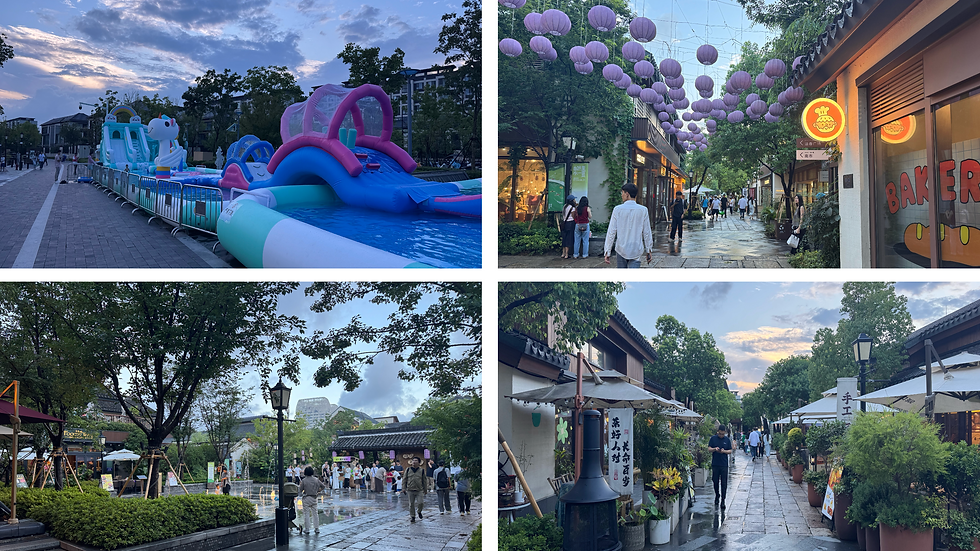
Panlong Tiandi is a modern commercial redevelopment of the historic Panlong Ancient Town, an old Jiangnan-style water town nestled in western Minhang. Originally dating back over 1,000 years to the Song Dynasty, the town had long faded into obscurity, with crumbling walls and forgotten bridges. But in recent years, it has been revitalized and reborn—painstakingly restored and expanded by Shui On Land, the developer behind Xintiandi, another main tourist destination in Shanghai, which we will cover in the later tours.
Unlike typical tourist water towns that rely on ticket sales and overly staged performances, Panlong Tiandi offers a more balanced, authentic experience. Here, the history is integrated—not just displayed. You’ll find stone-paved alleys, meandering canals, and preserved ancestral halls, all coexisting with contemporary cafés, art galleries, boutique bookstores, and design-forward tea houses.
One of the first things you’ll notice as you walk your bike through the area is the overwhelming peace. There's a gentle hush to Panlong—no honking, no blaring music, no commercial chaos. Just footsteps on stone, the soft buzz of conversation, and the occasional splash of a canal boat drifting under a low bridge. This isn’t a place to rush. It’s a place to breathe.
At the heart of the area are several small plazas, each themed with modern landscaping and public seating. Scattered throughout are sculptures, installations, and restored brick facades, blending Song Dynasty aesthetics with subtle contemporary flourishes. One corner might feature an old shrine carefully preserved behind glass, while the next turn takes you to a Blue Bottle Coffee tucked into a restored courtyard home.
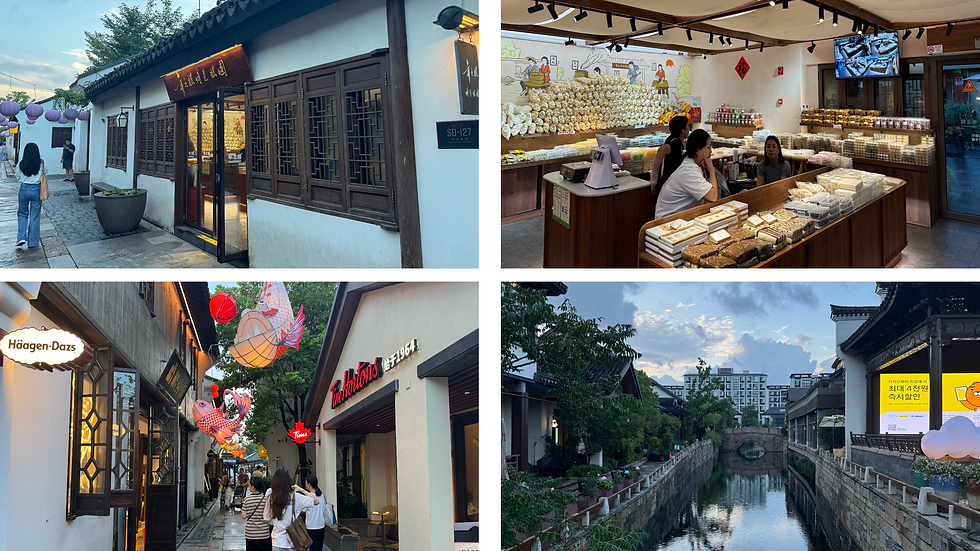
You’ll also find restored buildings repurposed as cultural centers, pottery workshops, and exhibition halls. On weekends, Panlong often hosts seasonal festivals, farmers’ markets, and design pop-ups—attracting families, young creatives, and couples looking for an artsy date spot. Unlike other malls or old towns, this area feels curated not for tourists, but for locals who appreciate slowness, beauty, and intentional design.
After walking through a couple of alleys, we stopped by my favorite spot in all of Panlong Tiandi—a tiny rice cake stall tucked into a quiet corner of the market area. As you see in the picture above, they serve a variety of soft, handmade glutinous rice cakes, but my go-to is always the 芒果糕 (mango rice cake). It’s slightly chilled, lightly sweet, and filled with a smooth mango paste that melts in your mouth. The outer layer is dusted with fine coconut flakes, giving it the perfect chew and balance. There’s nothing fancy about the place—just a couple of stools and a glass display—but it’s the kind of snack that sticks with you long after the ride is over. Panlong Tiandi isn’t just about the visuals—it’s about these quiet, flavorful moments that let you slow down and connect with the place, bite by bite.
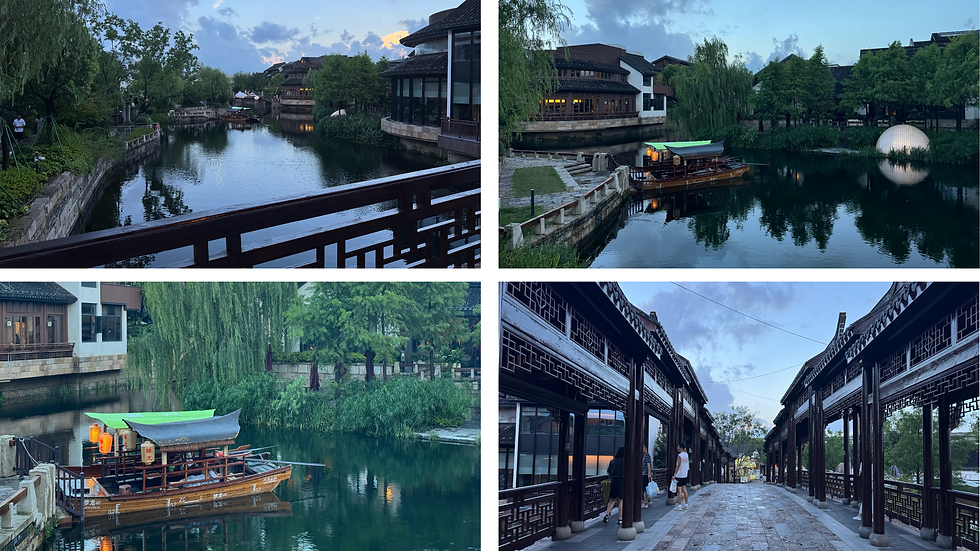

One of the most beautiful aspects of this place is how it’s car-free inside the core area. Bikes must be walked inside, but that only enhances the serenity. No loud engines, no aggressive scooters. Just stone paths, clear signage, and a layout that encourages exploration without stress.
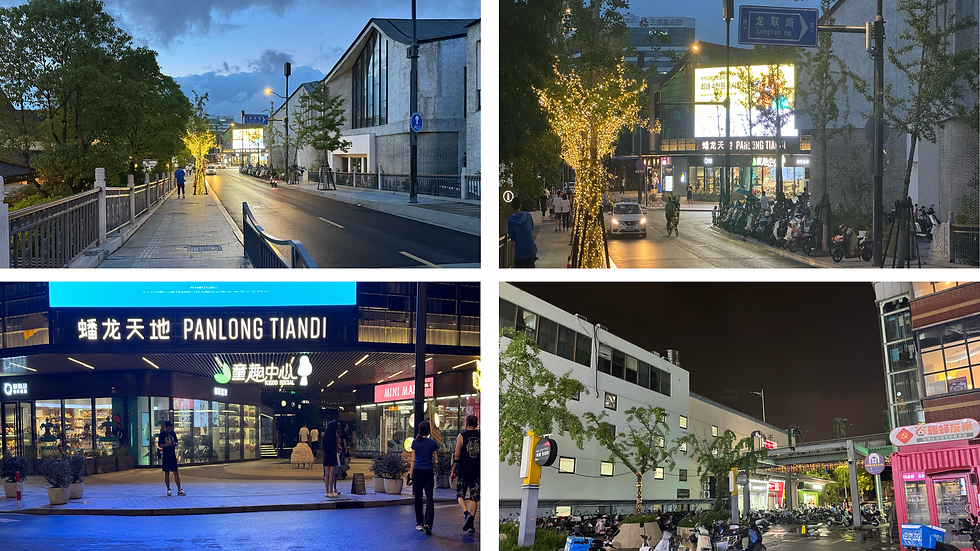
Panlong Tiandi also serves as a living case study of adaptive reuse in urban planning, transforming a fading relic into a thriving, community-oriented cultural district. It’s received attention from architectural and design communities across Asia for its thoughtful layout and sustainable approach.
As the sun began to set and lanterns lit up above the walkways, we realized how this stop didn’t just end the ride—it encapsulated everything the Bike in Shanghai project stands for: rediscovering places on two wheels, slowing down to see the layers of the city, and realizing that sustainability isn’t just about bike lanes or solar panels—it’s about how we reuse, preserve, and connect with the spaces we inhabit.
This marks the end of our ninth Shanghai tour, and I hope you all enjoy it as much as we did. Stay tuned for our bimonthly trip updates!


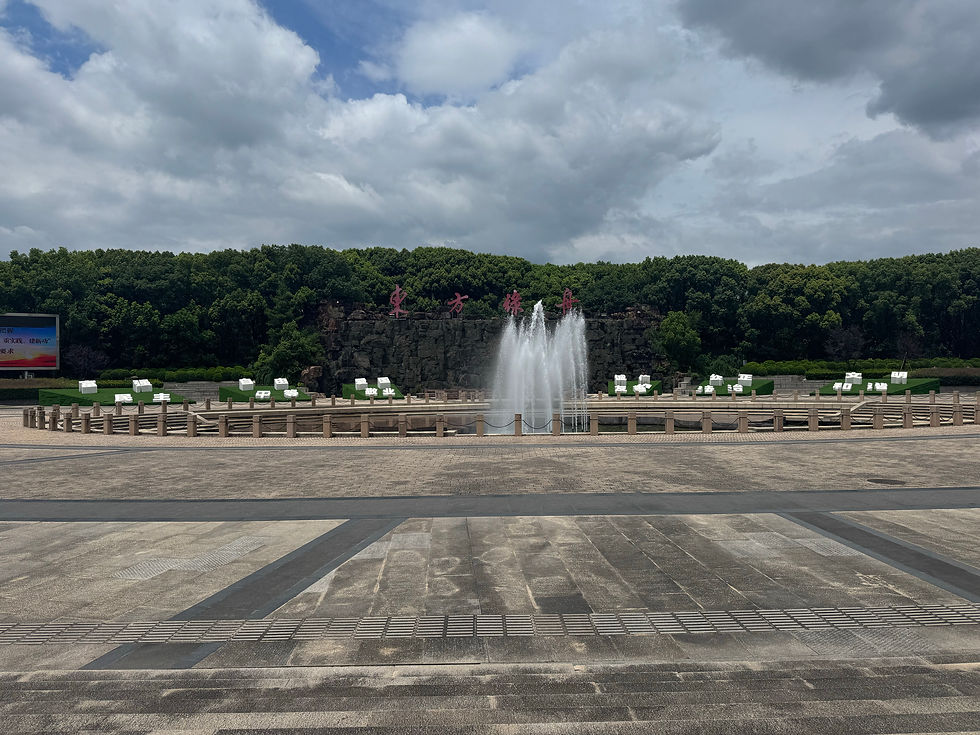

Comments